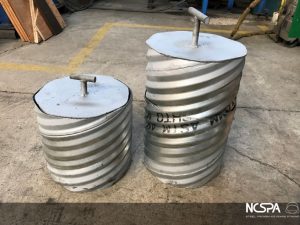By: Pacific Corrugated Pipe

Engineers from the Packaging Technology sector of Savannah River Nuclear Solutions contacted Pacific Corrugated pipe with a unique request. They wanted to understand if corrugated steel pipe could be produced in such a way that two segment cans would “thread” into each other. If this could be achieved, both ends of the smaller diameter pipe would have welded end caps and a simple handle welded to one end. The other would remain open on both ends and later be installed into the existing disposal drums used in the nuclear waste control process.
Savannah Nuclear Solutions advised PCP that the current product used for nuclear material transport does not perform as well as corrugated metal pipe in the destructive testing. The corrugation profile provides resistance to collapse during the destructive testing, which yielded improved impact results over alternate materials. Also, the corrugation profile used as a thread engages more easily than the product currently being used. To allow a smooth thread engagement PCP chose galvanized steel due to the reduced coefficient of friction compared to other products.
The pipe was run both with a regular lock-seam and also with a modified seam to reduce the thickness of the folded seam from 4 ply to 2 ply. The variance in diameter of the inside can versus the outside can was about 1.25”. To the extent that similar future opportunities arise for “threading” two pieces of corrugated steel pipe together, additional manufacturing process enhancements can likely be made to hold the overlap, shape, and diameter of the pipe with improved consistency (these attributes are difficult to maintain without the seaming die on the pipe fabricating mill). In the end the pipe was able to thread together with limited resistance which allows it to stay threaded once put together.